Everything you need to know about the compact Dodge Neon SRT-4
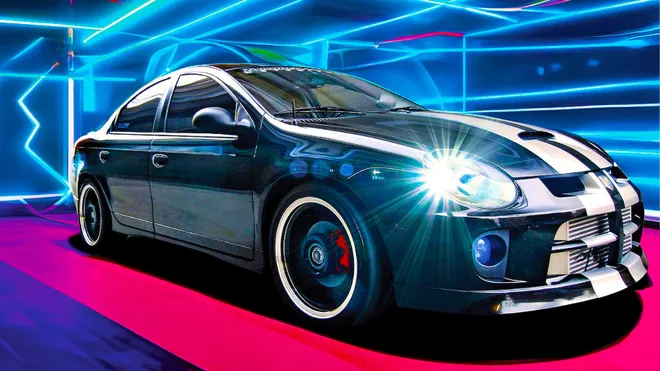
In the late 1990s and early 2000s, if you wanted a cheap, fast, sport-oriented car with a powerful, high-revving four-cylinder engine, your options were almost exclusively Japanese. Chrysler took notice of how Honda turned its basic commuter-appliance Civic into a respectable performance machine — the Si — and decided to create a domestic performance compact. But the process was different, as Chrysler would embrace its extensive experience with forced induction to create the brutish turbocharged Dodge Neon SRT-4. Read on for everything you've ever wanted to know about the Dodge Neon SRT-4’s short and fascinating run.
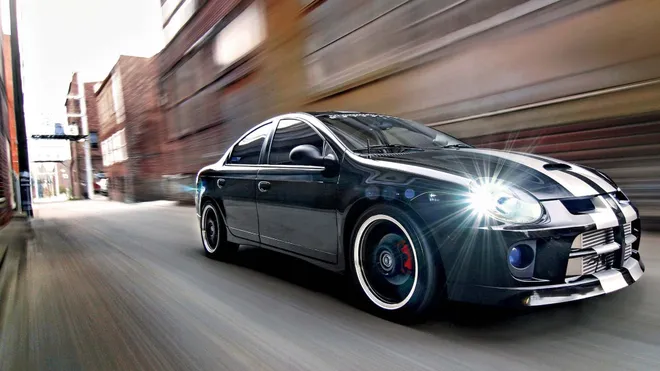
What was the Dodge Neon?
The Dodge Neon, which was also sold as a Plymouth Neon from 1994 until 2005, was designed to be a peppy, tossable, fun-to-drive car in economical compact sedan packaging. The Neon fell under the purview of then-President of Chrysler (and notorious enthusiast) Bob Lutz, who, for reference, had also green-lit the Dodge Viper and would go on to also develop the bombastic Plymouth Prowler, and later at GM guided the development of fun vehicles like the Pontiac Solstice/Saturn Sky and the Pontiac GTO. With that pedigree, it’s no wonder the Neon would be more exciting than the typical econobox of the ‘90s.
Initially available as a two-door coupe or four-door sedan, the standard Neon was outfitted with a 2.0-liter SOHC inline-four that produced 132 horsepower and 129 lb-ft of torque in its base form — respectable figures among its competition. An even livelier DOHC 2.0-liter four was available on higher trims which made 150 hp and 131 lb-ft of torque.
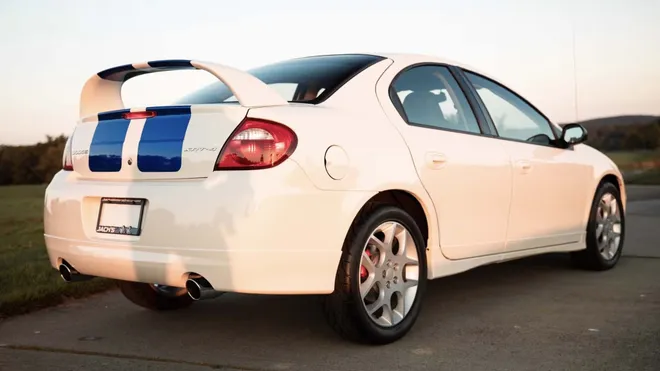
What’s the difference between a Dodge Neon and an SRT-4?
Think of the Dodge Neon and SRT-4 like Clark Kent and Superman. The base Neon was pleasant yet nondescript, but was a bit more powerful and athletic than its unassuming exterior let on.
After a quick change in a phone booth (remember those?), the SRT-4 transformed into a super-specialized performance machine. It was powered by a turbocharged and intercooled inline-four, making up to 230 horsepower in its final iteration. Its 2.25-inch exhaust used resonators with no mufflers for a perpetually angry rasp. Available only with a New Venture Gear T-850 5-speed manual with Sachs performance clutch, the SRT-4 was not for the faint of heart.
The Neon SRT-4 utilized bigger front and rear anti-roll bars, updated knuckles, a unique k-member, firmer springs (170-pound front/125-pound rear) and upgraded SRT-specific struts for improved handling.
However, its zero-camber factory alignment deterred it from posting better than 0.85g on our skidpad (versus the 0.87g posted by the Neon Sport Coupe we tested in 1995). But it is worth noting that the SRT-4's suspension did allow it to scamper through our 600-foot slalom in a devilish 66.6 mph, besting the Ferrari 575M Marenello.
Wider 17x6 cast aluminum wheels shod in sticky Michelin Pilot Sport tires measuring 205/50R-17 hid larger 11.0-inch front and 10.6-inch rear brakes helped slow the SRT-4 down from 60-0 mph in just 112 feet (versus 132 for the Sport Coupe). For context, a 2005 Lamborghini Gallardo needed 117 feet to perform the same function.
Visually, the SRT-4 sat lower than the stock car, and let’s not forget the functional hood scoop and “look at me” rear wing. While it couldn’t outrun a speeding bullet, the SRT-4 could make a Bullitt Mustang a little nervous.
2025 Ram 1500 Tungsten:The 4x4 High Output pickup goes hard
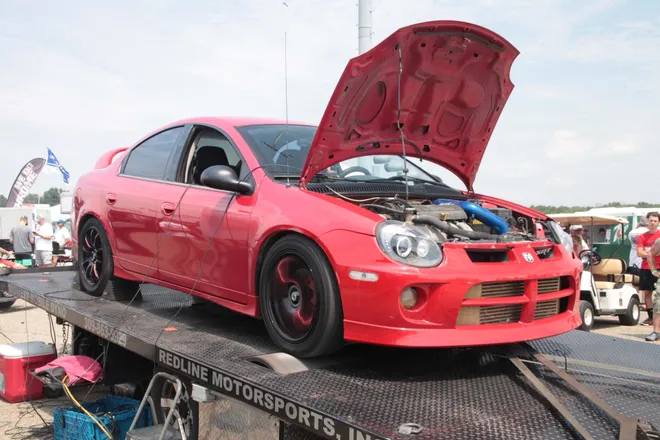
What engine does a Neon SRT-4 have?
The Dodge Neon SRT-4 uses a modified version of the brand’s 2.4-liter DOHC motor. With an iron block and an aluminum head, the SRT-4 engine runs at 8.1:1 compression and ingests up to 14 pounds of boost from a single Mitsubishi TD04-L-16GK turbocharger, with charge cooling provided by an eight-row Valeo air-to-air intercooler.
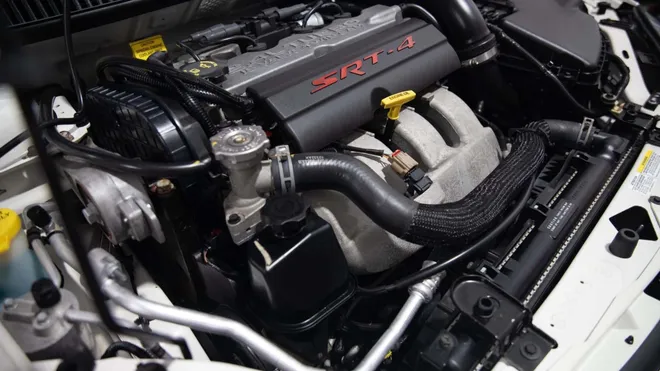
How much power does a Neon SRT-4 make?
When it made its debut in 2003, the SRT-4 made an impressive 215 horsepower at 5,200 rpm and 245 lb-ft of torque at 3,200 rpm. However, for 2004 and 2005, engineers gave the SRT-4 bigger fuel injectors and an upgraded and recalibrated NGC3 engine control module to allow a for a wider torque curve as well as peak boost right through to redline. Those two tweaks allowed the SRT-4 to make 230 hp at a higher 5,300 rpm and 250 lb-ft of torque at a lower 2,200 rpm, making the final two years of the hot-rod Neon noticeably quicker than its earlier iteration.
What does SRT stand for?
SRT stands for “Street and Racing Technology.” Much like AMG, M, or SVT have been used for their respective companies, Dodge used the SRT name for its highest-performance models. The Neon SRT-4 was the first SRT-badged vehicle to emerge. Initially, Chrysler (the parent company of Dodge) utilized a number after the SRT logo to denote how many cylinders that particular hi-po car or truck happened to have. The Dodge Viper SRT-10 used an 8.3-liter V-10, while the Jeep Grand Cherokee SRT-8 used a bored-out and hot-rodded Hemi V-8. The Dodge Neon SRT-4, as you might have put it together by now, used a high-powered four-banger.
Why did Dodge build the SRT-4?
While Bob Lutz (deservedly) gets credit for Chrysler’s resurgence in the 1990s, it was Tom Gale who was Chief of Design during that time — and the man who was responsible for the wild Viper, Prowler and Stealth helped bring the Neon SRT-4’s conceptual predecessor — the Neon SRT Concept — to life. With the sportiest iterations of the Neon being the R/T and ACR (more on that later), according to Car and Driver, Gale drew inspiration from the California tuner scene in the mid-to-late 1990s and went back to his team at Chrysler with the challenge to create a domestic option in what had traditionally been an import-only club. Suffice to say, Gale and his team succeeded in their mission, and the resulting SRT-4 serves as proof.
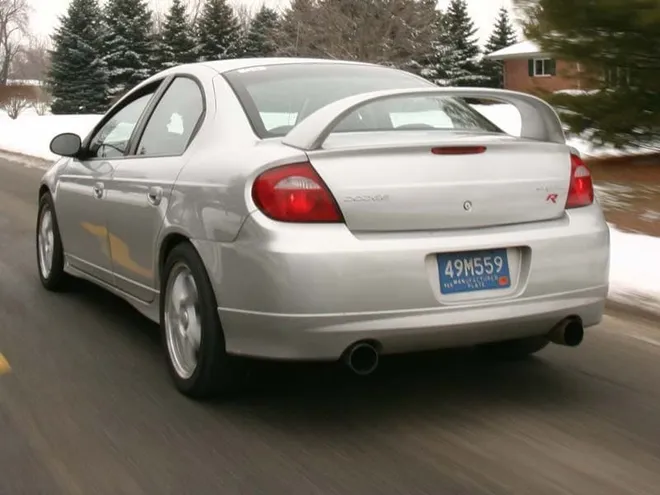
What is the 0-60 MPH time for a Dodge Neon SRT-4?
In the name of automotive science, we took more than a few SRT-4s to the track to sample its contagious turbocharged tenacity. With a bit of torque steer added to the mix, the quickest we’ve ever tested a Dodge Neon SRT-4 was back in 2003 when we ran it from 0 to 60 mph in just 5.4 seconds. While that may not seem exceptionally quick compared to some of today’s machines, it was good enough to put a beat down on the legendary tuner legend, the 2001 Acura Integra Type R and its mighty B18 engine.
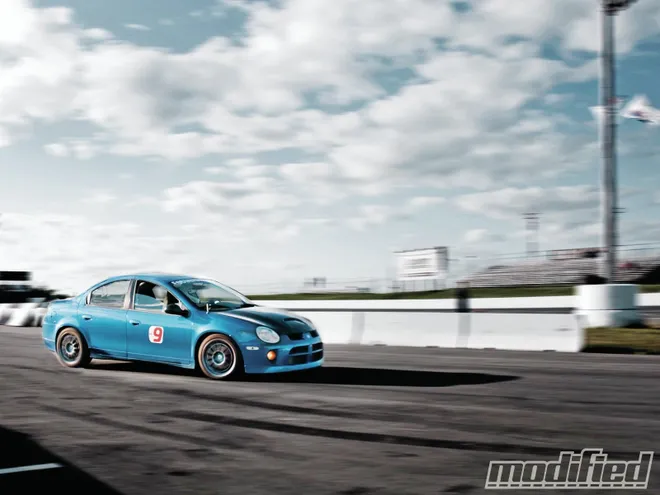
Is the Dodge Neon SRT-4 fast?
When it comes to other measures of performance, the SRT-4 can sprint from 0 to 60 mph in a mere 5.4 seconds, reach 100 mph in just 13.5 seconds, and tear through the quarter mile in 13.9 seconds at an impressive 102 mph. Its electronically limited top speed is 148 mph.
You’d be hard-pressed to find a quicker car for less money in any showroom in America when this car was new. In the early 2000s, the SRT-4 was fast for a production car. In a comparison test we did in 2005, the SRT-4 smoked a VW R32, kept up with a Nissan 350Z and was quick enough to make the more powerful Mustang GT keep an eye on its rearview mirror.
For some more contemporary context, those numbers match the Honda Civic Type R we tested in 2023 which benefits from 20 years of automotive advancement and 85 additional horsepower — and, when adjusted for inflation, the Type R is also several thousand dollars more than the Neon SRT-4’s original MSRP. Even decades later, the SRT-4 is still a performance bargain, as seen on our list of cheap, fast cars under $25,000.
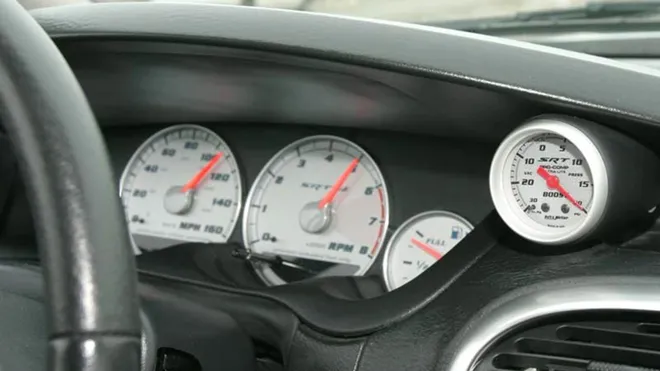
What performance upgrades were available for the Dodge Neon SRT-4?
The Street and Racing Technology team was just as speed-crazed as you’d imagine, and they had deep enough pockets to dip into when they wanted to show off. Once they saw how much fun SRT-4 owners had, they decided to offer a series of turbo upgrades for their pint-sized powerhouse. How fast you wanted to go depended on how much money you wanted to spend. The Mopar Performance Stage 1 kit, for $399, allowed the SRT-4 to make an additional 10 horsepower and 10 lb-ft of torque. This kit offered upgraded injectors that pumped 577cc/min at 58 psi and a retuned Powertrain Control Module that bumped up part- and wide-open throttle boost levels and gave the SRT a throatier exhaust note, particularly on deceleration.
The Stage 2 kit used even larger fuel injectors (682cc/min). A Stage 2 PCM increased part-throttle and WOT boost, while also employing a boost hold feature during WOT. Redline also increased from 6,200 rpm to 6,500 rpm. In total, the Stage 2 kit pumped things up to 265 hp for $1,599.
2025 Dodge Ram 1500:Say goodbye to the Hemi V-8. We don't miss it.
At the top of the SRT-4 engine horsepower food chain was the incredible Stage 3 kit, which swapped out the stock SRT-4's turbo for a larger Mitsubishi TD05HR turbocharger as well as a high-flow fuel pump and Stage 3 PCM programming. This final stage of upgrade brought power up to a stunning 310 hp and 325 lb-ft of torque (which made 355 hp and 365 lb-ft on 100-plus octane fuel). The Stage 3 kit came with a price tag of $4199.
What was the Dodge Neon SRT-4 ACR?
Much like Dodge’s big, bad Viper ACR, the American Club Racer version of the SRT-4 was offered for 2005 for $1,195 over the base car’s MSRP. The SRT-4 ACR came with the following performance upgrades:
- Lightweight 16-inch BBS wheels
- 225/45ZR-16 BF Goodrich KDW2 tires
- Five-way adjustable Tokico dampers
- Rear tension strut
- Larger front anti-roll bar
- Seats made to accommodate shoulder harnesses
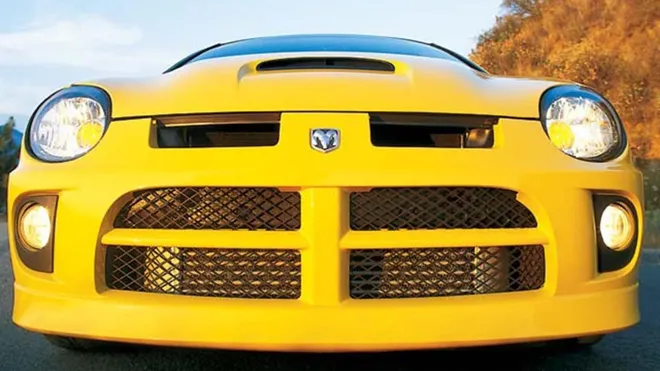
How many Dodge Neon SRT-4s were made?
During its three-year production run, the Neon SRT-4 was appropriately offered in four colors each year. The following are production numbers of Dodge’s pocket-rocket by color for each year:
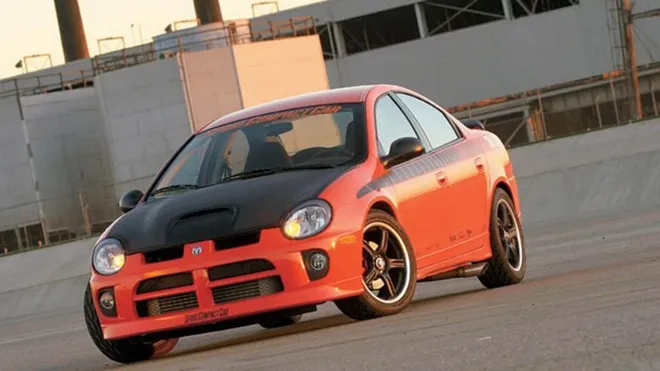
How much was a Dodge Neon SRT-4 new?
The Neon SRT-4 was built as an affordable high-performance performance car to challenge sporty import rivals. Its initial base price of under $20,000 made for a stellar selling point despite being around $3,000 higher than the former top-dog Neon R/T. Even as that starting point crept up slightly over the next two years, it wasn’t until 2005 that Dodge offered more than two options. The following is a list of all the options available for each year of the SRT-4.
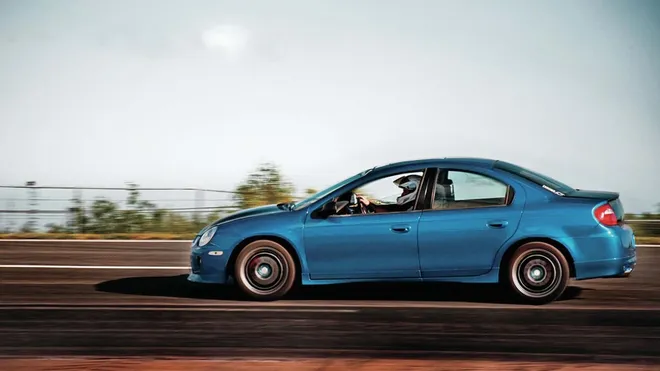
How much is a Dodge Neon SRT-4 today?
According to Classic.com the average resale price of a Dodge Neon SRT-4 (as of this writing) is $11,475. The lowest recorded sale checks in at just $8,600, while the highest just about doubles that at a still-very-reasonable $16,500.
Dodge Neon SRT-4 specs
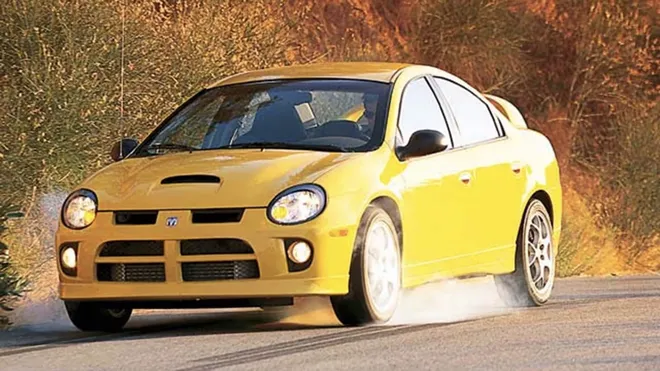
Dodge Neon SRT-4 FAQ
What does SRT stand for?
- SRT stands for “Street and Racing Technology,” and the Neon SRT-4 was the first SRT-badged vehicle.
What engine does the Neon SRT-4 have?
- The SRT-4 uses a turbocharged and intercooled 2.4-liter DOHC inline four-cylinder engine.
How much power does a Neon SRT-4 make?
- Initially, in 2003, the SRT-4 made 215 hp and 245 lb-ft of torque. That power peak was raised to 230 hp and 250 lb-ft for 2004 and 2005.
How fast is the Dodge Neon SRT-4?
- We clocked the SRT-4 from 0 to 60 mph in 5.4 seconds, 0–100 mph in 13.5 seconds and the quarter mile in 13.9 seconds at 102 mph. The top speed was limited to 148 mph.
What year did Dodge make the SRT-4?
- The Neon SRT-4 debuted in 2003 and ended production in 2005.
Photos by Mecum Auctions and Alan Muir
Disclaimer: The copyright of this article belongs to the original author. Reposting this article is solely for the purpose of information dissemination and does not constitute any investment advice. If there is any infringement, please contact us immediately. We will make corrections or deletions as necessary. Thank you.







